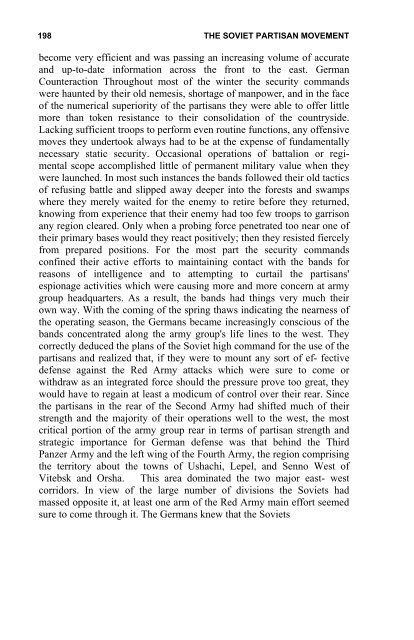the soviet partisan movement 1941-1944 by edgar m. howell
the soviet partisan movement 1941-1944 by edgar m. howell
the soviet partisan movement 1941-1944 by edgar m. howell
You also want an ePaper? Increase the reach of your titles
YUMPU automatically turns print PDFs into web optimized ePapers that Google loves.
198 THE SOVIET PARTISAN MOVEMENT<br />
become very efficient and was passing an increasing volume of accurate<br />
and up-to-date information across <strong>the</strong> front to <strong>the</strong> east. German<br />
Counteraction Throughout most of <strong>the</strong> winter <strong>the</strong> security commands<br />
were haunted <strong>by</strong> <strong>the</strong>ir old nemesis, shortage of manpower, and in <strong>the</strong> face<br />
of <strong>the</strong> numerical superiority of <strong>the</strong> <strong>partisan</strong>s <strong>the</strong>y were able to offer little<br />
more than token resistance to <strong>the</strong>ir consolidation of <strong>the</strong> countryside.<br />
Lacking sufficient troops to perform even routine functions, any offensive<br />
moves <strong>the</strong>y undertook always had to be at <strong>the</strong> expense of fundamentally<br />
necessary static security. Occasional operations of battalion or regimental<br />
scope accomplished little of permanent military value when <strong>the</strong>y<br />
were launched. In most such instances <strong>the</strong> bands followed <strong>the</strong>ir old tactics<br />
of refusing battle and slipped away deeper into <strong>the</strong> forests and swamps<br />
where <strong>the</strong>y merely waited for <strong>the</strong> enemy to retire before <strong>the</strong>y returned,<br />
knowing from experience that <strong>the</strong>ir enemy had too few troops to garrison<br />
any region cleared. Only when a probing force penetrated too near one of<br />
<strong>the</strong>ir primary bases would <strong>the</strong>y react positively; <strong>the</strong>n <strong>the</strong>y resisted fiercely<br />
from prepared positions. For <strong>the</strong> most part <strong>the</strong> security commands<br />
confined <strong>the</strong>ir active efforts to maintaining contact with <strong>the</strong> bands for<br />
reasons of intelligence and to attempting to curtail <strong>the</strong> <strong>partisan</strong>s'<br />
espionage activities which were causing more and more concern at army<br />
group headquarters. As a result, <strong>the</strong> bands had things very much <strong>the</strong>ir<br />
own way. With <strong>the</strong> coming of <strong>the</strong> spring thaws indicating <strong>the</strong> nearness of<br />
<strong>the</strong> operating season, <strong>the</strong> Germans became increasingly conscious of <strong>the</strong><br />
bands concentrated along <strong>the</strong> army group's life lines to <strong>the</strong> west. They<br />
correctly deduced <strong>the</strong> plans of <strong>the</strong> Soviet high command for <strong>the</strong> use of <strong>the</strong><br />
<strong>partisan</strong>s and realized that, if <strong>the</strong>y were to mount any sort of ef- fective<br />
defense against <strong>the</strong> Red Army attacks which were sure to come or<br />
withdraw as an integrated force should <strong>the</strong> pressure prove too great, <strong>the</strong>y<br />
would have to regain at least a modicum of control over <strong>the</strong>ir rear. Since<br />
<strong>the</strong> <strong>partisan</strong>s in <strong>the</strong> rear of <strong>the</strong> Second Army had shifted much of <strong>the</strong>ir<br />
strength and <strong>the</strong> majority of <strong>the</strong>ir operations well to <strong>the</strong> west, <strong>the</strong> most<br />
critical portion of <strong>the</strong> army group rear in terms of <strong>partisan</strong> strength and<br />
strategic importance for German defense was that behind <strong>the</strong> Third<br />
Panzer Army and <strong>the</strong> left wing of <strong>the</strong> Fourth Army, <strong>the</strong> region comprising<br />
<strong>the</strong> territory about <strong>the</strong> towns of Ushachi, Lepel, and Senno West of<br />
Vitebsk and Orsha. This area dominated <strong>the</strong> two major east- west<br />
corridors. In view of <strong>the</strong> large number of divisions <strong>the</strong> Soviets had<br />
massed opposite it, at least one arm of <strong>the</strong> Red Army main effort seemed<br />
sure to come through it. The Germans knew that <strong>the</strong> Soviets
















